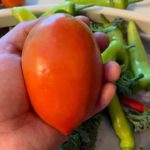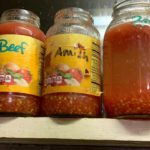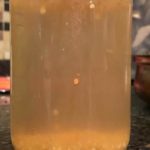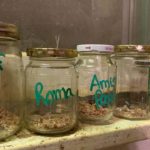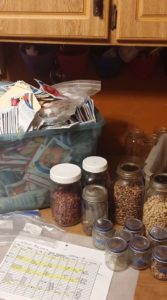This time of year there are plenty of seeds everywhere. Your broccoli, if left in the ground, has sprouted flowers which have turned into seed pods. Maybe there are some cucumbers that were oddly shaped that were left behind and now have yellowed and are beginning to dry out. Perhaps you lost a zucchini out there and it’s now turning yellow and well beyond the acceptable period for consumption. Maybe your radishes have produced seed pods that are drying. Being new to seed saving, you are interested in saving all the seed you can to reduce your costs next year, right? So out to the garden you go, collecting seeds for next years garden.
Please don’t. I don’t say this to burst your bubble, but to prevent you from having a less than desirable outcome next season. Every year I see people excitedly saving seed from everything in their garden, but this is the only time of year they have even thought about saving seed. Saving seed now, without any prior planning, will not yield the results you are hoping for (in most cases). There are some fairly foolproof plants you can save seed from successfully such as tomatoes, beans, peas and lettuce. They have different methods for harvesting and cleaning the seed, which I will be covering shortly. Saving seed is an intentional activity that should be included in your garden planning- well before any seeds have been started. And there are things to think about for long-term success.
Let me tell you why.
First, the type of seed you originally planted is perhaps the biggest determining factor to seed saving success. The goal here is to grow plants true-to-type, which means if you planted a Roma tomato, you want to grow a Roma tomato with the exact same qualities, right? You are counting on certain characteristics to show themselves again. Do you remember exactly what type of seed you planted and are trying to save? Are you certain that what you planted was open pollinated or heirloom variety and not a hybrid? Hybrid seed is a crossbred between two parent plants. That means if you save that seed, what you will grow next year will not be true-to-type. It may grow. It may even produce. But it won’t be what you expected and might even be disappointing.
Second, do you remember the variety? Us gardeners like to plant a lot of varieties of the same plants in our garden. But knowing what variety you planted is really important. Different varieties have different qualities that you want to keep growing true-to-type and it is important to be able to identify varieties to ensure quality and characteristics are what they should be.
Third, Did you do anything to prevent cross pollination? Some plants are self pollinating, but many are not. Wind and insects are responsible for the pollination – and that could include carrying pollen from different varieties which would then make the seed from that produce a hybrid. The seed will still look exactly the same, but when you plant it, you may notice different characteristics. Even self pollinated plants can occasionally be cross pollinated by insects. Methods to prevent cross pollination between varieties include caging, netting (hand pollination by you may be necessary), blossom bagging, time (if your season is long enough and your varieties allow for it, you can plant one variety early and plant the next variety when the first variety is blooming, so the insects only pollinate one variety at a time), and isolation distance. Isolation distances are often quite out of reach for a home gardener though, so I recommend other methods of isolation. Also keep in mind, even if you are being careful to only grow vegetables that will not cross pollinate, your neighbors may be growing something that will. Some people prefer to keep varieties separated on their side of their property with pollinator distractions in the middle and/or tall buildings or landscape features to interrupt the flow of wind. Both of these are said to possibly prevent cross pollination as insects will drop their pollen elsewhere (with other blooming distractions) before making their way back to the other side of your garden, and buildings or even tall plants like sunflowers, can interrupt windflow and prevent cross pollination there. Another point related to cross pollination is that some weeds from our yard, the neighbors or a nearby field will cross pollinate with certain plants in our gardens too!
Fourth, Are you saving seed from a variety of plants that are growing true-to-type? Did you save some of your very best vegetables for seed saving or did you eat them all? As a seed saver, it is important to pay attention to the plants we wish to save seed from all season, not just at harvest time. And, we don’t want to leave all of the smaller, poorly shaped produce to save seed from – nor do we want to save just the biggest and the best. In fact, the plants that we wish to save seed from have many characteristics that are very important that go beyond the actual vegetable its self. Plants that bolted early, developed blight, have oddly shaped fruit, have smaller leaves, slower growth – these are all characteristics you don’t want to encourage in the following generations. However, a plant with good vigor, one that is slow to bolt, has insect resistance, stockiness, hardiness, uniformity, and earliness are characteristics that you should want to encourage. Select seed to save from those types of plants.
Fifth, Did you plant enough for genetic diversity? Population is very important, but not many people think about it. This is another important factor that needs to be considered before you begin planting seeds in the spring. To avoid decreasing the genetic diversity within a crop, you should save seed from as many plants as possible that have the very best characteristics (remember, this goes beyond the vegetable its self). Maintaining genetic diversity within your plant population is important for continued evolution and adaptation to changing conditions in their environment. So, instead of looking to save seed only from the plants that produced the biggest and best vegetables, aim to select a large number of seeds from plants that have the qualities desired in the variety you are growing. Even though it may not have produced the biggest and best produce on every plant, perhaps the plants are still true-to-type and display the characteristics that you wish to encourage. There are a minimum number of plants that should be grown of certain varieties to ensure genetic diversity. Genetic diversity probably won’t even be something that will affect you for at least a few generations – but ensuring it now will pave the road for your success years from now. If your space is limited, maybe you could form a group with neighbors and share the growing? How neat would that be!
Some plants don’t set seed until the following year. For those, such as beets and carrots, you will need to keep them alive through the winter. In our climate you would need to dig them out and keep them alive in your house before replanting the following year.
These are just a few questions to ask yourself before you save that seed – some vegetables do self pollinate and the risk of cross pollination is low, but as you can see from above there is much more to seed saving than just the seeds. A lot of observation through the entire growing season is necessary for best results, and planning prior to planting to allow for proper isolation and population sizes is very important as well.
Whatever seed you do save, be sure to label it!! I don’t mean simply ‘tomato’ but, include the variety.
If you are certain you planted open pollinated or heirloom seeds, and you want to try seed saving just to try the process (and have a good chance at success), you can start with common beans, peas, tomatoes and lettuce. Heck, you could try saving the seed of anything really, but please do so knowing that it may not produce the results you are hoping for. I just wanted to give you some questions to ask yourself before you run out to save seed that might not end well for you.
I will be covering much more about seed saving and teaching a class sometime later in the winter, giving you plenty of time to think about the important factors and to help you with your spring planting. I have been saving seed in my garden on many things for many years and while it has been a little extra planning, planting and observing, it has helped preserve varieties I enjoy, saved a lot of money not having to buy the seed, and has given me another step toward self sustainability. I really enjoy it, and I hope you will, too.
Here is an incredibly helpful chart on seed saving that covers isolation distances, population numbers to preserve genetic diversity, pollination methods and much more. Print this, you will want to refer back to it often.
